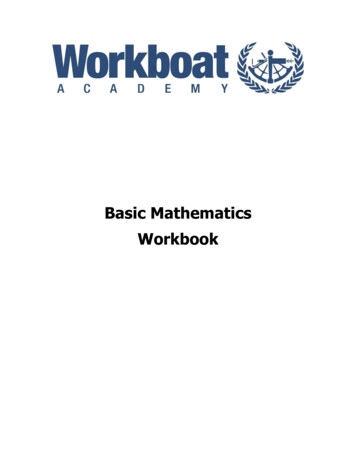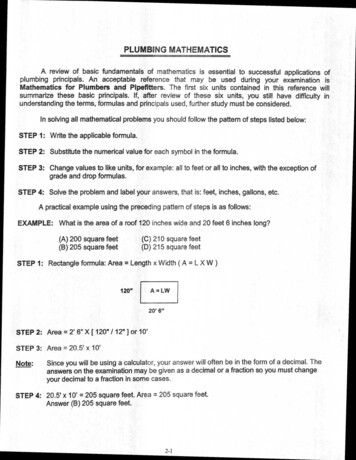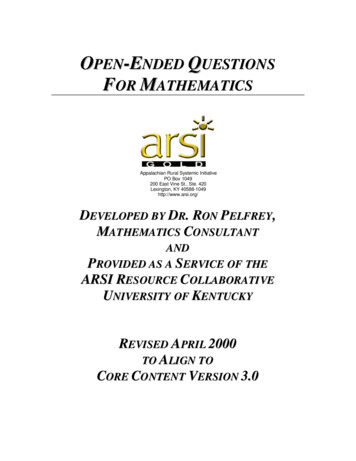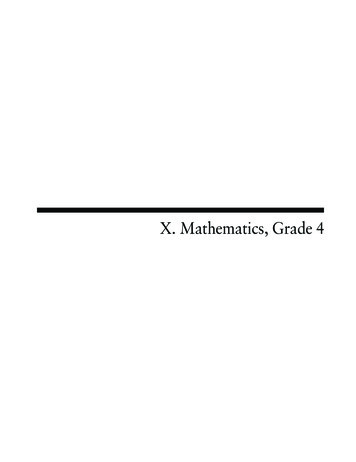
Transcription
Basic MathematicsWorkbook
Workboat Mate ProgramBasic MathematicsWorking with Basic MathematicsIntroductionThank you for applying to join the Workboat Academy. This new and excitingprogram will develop your skills, knowledge and understanding so that you can besuccessful as a professional mariner.Basic math skills are an important element of everyday shipboard life. You will needa solid foundation of these skills in order to succeed in this training program.Therefore, as a prerequisite to being admitted into our program, you have tocomplete the “Math Competency Exam”. This Workbook will help you prepare forthat exam.The purpose of the exam is to enable you to self-screen your skills and abilitiesagainst those that are reflected and expected in the coursework of the WorkboatAcademy. It is imperative that you appreciate the importance of the exam andrecognize the level of math aptitude that is necessary to successfully complete yourintended program.Please note that the distribution of the exam is limited; do not copy or furtherdisseminate the exam.“Working With Mathematics” is a self study guide designed to teach or refresh basicmath skills needed for the Workboat Academy. It is divided into eight trainingmodules. Each training module includes example problems with solutions, as wellas additional online references to further assist you with the skills presented in thatspecific module. It is important that you understand each training module and howto work the various problems before you take the Math Competency Exam.In addition to this Workbook and the suggested websites, it is highly recommendthat you seek additional reference from the following text: Formulae for the Marinerby Richard Plant. Formulae for the Mariner is an inexpensive resource that may aidin the fine tuning of your skills for this Math Exam, and it will also serve as avaluable reference for your future career as a mariner.April 2013
Workboat Mate ProgramBasic MathematicsModules1.2.3.4.5.6.7.8.Order of Operations .4Solving Equations .9Basic Formulas . 14Latitude and Longitude . 21Time . 26Degrees . 31Tables . 36Triangles . 41Note:It is highly recommended that you purchase your own calculator. Any intermediate scientificcalculator will work as long as it has a Sin, Cos, Tan, square, and square root keys. The calculatorshould also have stow and recall functions. We recommend the Sharp EL-531. Being familiar withyour own personal calculator will greatly assist your success.April 2013
Workboat Mate ProgramBasic MathematicsThis page intentionally left blankApril 2013
Workboat Mate ProgramOrder of Operations1. Order of OperationsThe first step to solving equations and applying formulas is the basic step ofunderstanding the correct order of operations. Knowing and using the correctsequence of steps is the best way to ensure you are on the path to correctly solvingmathematical problems.The order of operations is as follows:1.2.3.4.Solve all the operations that lie inside brackets and parenthesesSolve all operations involving exponents or radicalsFrom left to right, solve all multiplication and divisionFrom left to right, solve all addition and subtractionWhen a problem contains multiple operations, it is imperative that you follow theorder of operations because solving the operations in different sequences willproduce different results.Example #1: Solve the following, using the correct order of operations.7–8 2 XSolving from left to right, we can see that:7–8 2 X-1 2 X1 XExample #2: Solve the following, using the correct order of operations. This timenote the use of parenthesis.7 – (8 2) XSolve the operations inside the parenthesis first.7 – (8 2) X7 – (10) XThen solve the remaining operation.7 – (10) X-3 XAs you can see in the Examples, changing the order of operations and/or addingparenthesis to an equation changes the result. In order to obtain the correct result,you must remember and perform the correct order of operations.April 2013
Workboat Mate ProgramOrder of OperationsFor additional reference, please visit:www.khanacademy.org-- Arithmetic & Pre-algebra-- Addition & Subtraction of numbers-- Multiplication & Division of numbers-- Negative numbers & absolute value-- Negative numbers basics-- Adding and subtracting negative numbers-- Multiplying & dividing negative numbersApril 2013
Workboat Mate ProgramOrder of OperationsPractice Problems #1:Solve the following:1. -2 9 2. -2 – 9 3. -2 – (-9) 4. 4 – 5(6 – 1) 5. (5 – 3)2 4 6. [8(6 – 2)] 3 7. (81 9) – 2 8. 5 (-10) – 3 9. 7 4(9-5) 3(8-5) 10. 9 – 2 6 April 2013
Workboat Mate ProgramOrder of OperationsAnswers to Practice Problems #11. 72. -113. 74. -215. 86. 357. 78. -89. 3210. -3April 2013
Workboat Mate ProgramOrder of OperationsThis page intentionally left blankApril 2013
Workboat Mate ProgramSolving Equations2. Solving EquationsAfter mastering the order of operations, you can solve basic algebraic equationswhere there is an unknown value called a variable. In this Workbook, the variablewill be X; thus, we are solving equations for X. However, variables may berepresented by any letter of the alphabet. In a single equation, the value of thevariable must remain the same throughout the problem.In order to solve for X, you want to isolate X on one side of the equation. It ishelpful to think of the equation as something you want to keep balanced. If youperform one operation on one side of the equation (in an effort to isolate X), thenyou must perform that same operation on the other side of the equals ( ) sign ofthe equation.You can always check your solution by plugging in your answer in the equationwhere X appears. Then, solve the equation and ensure the equation (and thusyour answer for the variable) is correct.Example #1: Solve the following for X.X2 – 49 0To isolate X, we can add 49 to both sides of the equation.X2 49To further isolate X, we can take the square root of both sides of theequation.X 49X 7Because ( 7)2 and (-7)2 both equal 49, in this problem, X 7 and -7Example #2: Solve the following for X.X 5 2XTo isolate X, we can subtract X from both sides of the equation.5 2X – XApril 2013
Workboat Mate ProgramSolving EquationsWe can now simplify (by subtraction) on the right side:5 XFor additional reference, please visit:www.khanacademy.org-- Algebra-- Introduction to Algebra-- Linear equations-- Systems of equations inequalities-- Simple equationsApril 2013
Workboat Mate ProgramSolving EquationsPractice Problems #2:1.2.3.4.5.X 23 2XX2 - 81 0X 3 203X 8 -2X 94X 16April 2013
Workboat Mate ProgramSolving EquationsAnswers to Practice Problems #21.2.3.4.5.23 9601/54April 2013
Workboat Mate ProgramSolving EquationsThis page intentionally left blankApril 2013
Workboat Mate ProgramBasic Formulas3. Working with Basic FormulasWorking with and understanding basic formulas and how to arrange them is animportant skill necessary in today’s world, especially for an officer on a moderncommercial vessel.Let’s look at a basic formula to calculate Distance, Time, and Speed. The simpleformula is: D S x T.Where: D Distance (usually expressed in nautical miles)S Speed (usually expressed in knots)T Time (expressed in hours and/or minutes, or tenths of a minute)Example #1: Your vessel is traveling at 18 knots and you travel for 2 hours. Howfar did you travel?Distance Speed x TimeD SxTD 18 kts x 2 hoursD 36 nautical miles (nm)Example #2: Your vessel is traveling at 14 knots and you travel for 3 hours and 15minutes.Note: Since calculators perform their functions in tenths, and we are working withtime, which is in hours, minutes and seconds, we need to convert the 15 minutes totenths of an hour. This is easy. Simply divide the 15 minutes by 60 (minutes in onehour). The answer is 0.25 of an hour. This makes sense since 15 minutes is onequarter of one-hour.The same process is used to convert tenths of a minute. Since there are 60 secondsin a minute, we simply divide the number of seconds by 60 to convert to tenths of aminute. 54 seconds is how many tenths of a minute?54 60 0.9 tenths. To check your results multiply 0.9 x 60 54 seconds.Seconds / Minutes6 sec 1/10th of a minute12 sec 2/10th of a minute18 sec 3/10th of a minute24 sec 4/10th of a minute30 sec 5/10th of a minute36 sec 6/10th of a minute42 sec 7/10th of a minute48 sec 8/10th of a minute54 sec 9/10th of a minute60 sec 10/10th of a minuteMinutes / Hours6 min 1/10th of an hour12 min 2/10th of an hour18 min 3/10th of an hour24 min 4/10th of an hour30 min 5/10th of an hour36 min 6/10th of an hour42 min 7/10th of an hour48 min 8/10th of an hour54 min 9/10th of an hour60 min 10/10th or 1 hourApril 2013
Workboat Mate ProgramBasic FormulasNow back to our problem: Your vessel is traveling at 14 knots and you travel for 3hours and 15 minutes. How far did you travel?D SxTD 14 kts x 3:15D 14 x 3.25 (remember to convert minutes to tenths)D 45.5 nmHow do we find the speed of our vessel? We need to rearrange the basic formula:D S x T.In any formula where the answer is the product of two numbers, we can use thefollowing simple diagram to help us rearrange the formula. By rearranging theformula we can solve for any unknown.Given distance (D) and time (T) we can calculate the speed oftravel. In the diagram D is over T, so divide D by T to calculatethe speed (S).DSTThe new formula would look like this:S DT orS D T. The same rules apply to convert minutes to tenths of a minute.Example #3: What speed is your vessel making if you traveled 45 nm in 3:36?S DTS 45 nm3:36 (36 minutes 60 0.6 of a hour)S 453.6S 12.5 ktsApril 2013
Workboat Mate ProgramBasic FormulasHow do we find how long it will take for our vessel to travel over a certain distanceat a given speed? We need to rearrange the basic formula: D S x T.In the diagram D is over S, so divide D by S to calculate the speed (S).The new formula would look like this:DSTT DS orT D SExample #4: How long (time) will it take your vessel to reach its destination if youtravel 35 nautical miles at a speed of 19 knots?T DST 3519T 1.84 hours. (How many minutes is 0.84 hours? 0.84 x 60 50.4 minutes)T 1 hour 51 minutesWe also need to be able to work with positive ( ) and negative (-) numbers.Adding positive numbers:4.3( ) 5.810.1Adding negative numbers:-5.4( )-2.7-8.1April 2013
Workboat Mate ProgramBasic FormulasFor additional reference, please visit:www.khanacademy.orgScience, Physics, Mechanics-- Solving for timewww.ehow.com-- Calculating for average velocity or speedhttp://msi.nga.milAmerican Practical Navigator-- Time, speed and distance,-- Table 11 explanation, page 559-- Table 11, page 676April 2013
Workboat Mate ProgramBasic FormulasPractice Problems #3:Speed1. 13.62. 8.03. 6.54.5. 7.06. 10.07.8. 7.39. 9.010.Time2 hr 12 min1 hr 36 min4 hr 09 min3 hr 54 min9 hr 48 min8 hr 08 min10 hr 41 minDistance1444291078257Convert the following:1. 10.3 min to minutes and seconds2. 12.23 min to minutes and seconds3. 15 min 42 seconds to minutes and tenths of a minute4. 72 minutes to hours and tenths of an hour5. 2.6 hours to hours and minutes6. 232 minutes to hours and minutesPositive and negative numbers:1.23.8 14.92.-42.8( ) -17.73.105( ) - 28April 2013
Workboat Mate ProgramBasic FormulasAnswers to Practice Problems #31. 29.9 miles2. 12.8 miles3. 2 hr 09 min4. 10.6 knots5. 27.3 miles6. 2 hr 54 min7. 10.9 knots8. 59.4 miles9. 9 hr 07 min10. 5.3 knots1.2.3.4.5.6.10 min 18 sec12 min 14 sec15.7 min1.2 hours2 hrs 36 min3 hrs 52 min1. 38.72. -60.53. 77April 2013
Workboat Mate ProgramBasic FormulasThis page intentionally left blankApril 2013
Workboat Mate ProgramLatitude and Longitude4. Latitude and LongitudeLatitude and longitude create a grid system on the globe as one method ofidentifying location. Latitude and longitude are measured in degrees ( ).Lines of latitude run horizontally and are parallel, because they are equal distancefrom each other. They are numbered 0 – 90 , and they are labeled as North orSouth (in relation to the equator, which is 0 ).Lines of longitude run vertically. Although latitude lines can also be called parallels,longitude lines cannot. Instead, they are also known as meridians. They arenumbered 0 – 180 , and they are labeled as East or West (in relation to Greenwich,England, which is 0 ).To further identify a specific location on Earth, both longitude and latitude can bemeasured in degrees, minutes, and seconds. There are 60 minutes in each degree,and each minute is divided into 60 seconds.Source: www.about.comExample #1: Your vessel leaves Longitude 15 east and travels due east for 100 oflongitude. What is the longitude of arrival?If you begin at 15 east and are traveling another 100 in the same direction, youadd 15 east 100 east 115 east. If you look at the map above, you can seeApril 2013
Workboat Mate ProgramLatitude and Longitudethat longitude runs east until 180 . Because our answer is less than 180 , we cansee that 115 east is both practical and correct.Example #2: Your vessel leaves Latitude 15 south and travels due north for45 of latitude. What is the latitude of arrival?If you begin at 15 south and travel north, you can see that you will be headingtoward the Equator. You reach the Equator (0 ) after traveling 15 north.However, the question says you’ve traveled north for 45 of latitude. Out of thetotal of 45 latitude, we have already traveled 15 upon reaching the Equator, sowe have another 30 north to travel (45 - 15 30 ). When you travel theremaining 30 north from the Equator (0 ), you arrive at 30 north.For additional reference, please visit:www.khanacademy.org-- Math and Trigonometry-- Radians and degrees-- Parts of a circle-- Measuring angles in degreeswww.wikipedia.org-- Geographic Coordinate conversionwww.about.com-- Latitude and Longitudewww.ehow.com-- How to understand Latitude and Longitude-- How to find Latitude and Longitude-- How to read Latitude and LongitudeApril 2013
Workboat Mate ProgramLatitude and LongitudePractice Problems #4:1. A vessel leaves Longitude 45 east and travels due east for 110 of longitude.What is the longitude of arrival?2. A vessel leaves Latitude 35 north and travels due south for 50 of latitude.What is the latitude of arrival?3. A vessel leaves Longitude 35 west and travels due east for 110 of longitude.What is the longitude of arrival?April 2013
Workboat Mate ProgramLatitude and LongitudeAnswers to Practice Problems #41. 155 east2. 15 south3. 75 eastApril 2013
Workboat Mate ProgramLatitude and LongitudeThis page intentionally left blankApril 2013
Workboat Mate ProgramTime5. Working with TimeWe work with and calculate time in many ways in our everyday life. The ability toaccurately add and subtract units of time is an essential skill. Some shipboardoperations where this skill is employed include calculating the times of arrivals,optimum tides and currents, and celestial events such as the time of sunrise orsunset. In addition, having a solid grasp of calculating time is crucial to enteringmany nautical publications.In the maritime industry we always use the 24-hour clock, or military time:Midnight 0000 / 12 Noon 12001 AM 0100 / 1PM 13003 AM 0300 / 3 PM 15006 AM 0600 / 6 PM 18009 AM 0900 / 9 PM 2100Adding Time: (You may go over 60 minutes, therefore remember to add onehour)1233 062118541742 04272169 22090656 (May 1st) 195025:106 min 2646 0246 (May 2nd next day)Subtracting Time: (You may need to borrow one-hour or 60 minutes)1233-062106121737-09540743 (borrow 60 minutes from 1700 and add to the 37 min 97 min. Youcan then subtract 54 minutes from 97. 97 – 54 43)April 2013
Workboat Mate ProgramTime0239 (May 1st)- 1951Solution: In this problem we cannot subtract 1900 from 0200. 0200 is in themorning of the next day, so we need to add 24 hours to the 0200 2600. Now wecan subtract 19 from 26.0239 (May 2nd) 2599 (May 2nd)-1951-19510648 (May 1st)For additional reference, please visit:www.ehow.com-- How to find degrees in minutes and seconds-- How to calculate the fours between dateswww.springfrog.com-- Convert hours, minutes and seconds to decimal timewww.timeanddate.com-- Add or subtract hours from a dateApril 2013
Workboat Mate ProgramTimePractice Problems #5:Solve the following time problems:1.0344 May 15th 01336.1551 May 15th-13192.1604 May 15th 14147.0438 May 15th-00123.1911 May 15th 17258.0216 May 15th-23234.0150 May 15th 21049.1421 May 15th-12305.1108 May 15th 083710. 0912 May 15th-1635April 2013
Workboat Mate ProgramTimeAnswers to Practice Problems #51. 05172. 06183. 12364. 22545. 19456. 02327. 04268. 02539. 015110. 15th15th15th14th15th14thApril 2013
Workboat Mate ProgramTimeThis page intentionally left blankApril 2013
Workboat Mate ProgramDegrees6. Working with DegreesDoing calculations with degrees is very similar to working with time. Time isexpressed in hours, minutes and seconds (or tenths of a minute and seconds).Degrees are expressed in degrees (º), minutes (’), and seconds (”).Degree basics:60 seconds 1 minute60 minutes 1 degree10 degrees, 5 minutes, 28 seconds is written as: 10º 05’ 28”As in working with time, we may need to borrow (add or subtract) one degree (or60 minutes), or one minute (60 seconds). If you have more than 360 as ananswer, simply subtract 360 . You may have to add 360º before subtracting from asmall number.Adding degrees:10º 05’ 28” 12º 52’ 13”22º 57’ 41”28º 15’ 42”343 º 27’ 19” 47º 37’ 19” 31º 52’ 12”75º 53’ 01” 375 º 19’ 31”-360º15 º 19’ 31”Subtracting degrees:12º 52’ 13” 47º 37’ 19” 125º 16’ 27” 485 º (125 º 360º) 485º 16’ 27”- 6º 48’ 09” -29º 49’ 37” -237º 39’ 22”-237º 39’ 22”6º 04’ 04” 17º 47’ 42”247º37’05”Working with CirclesMost of us have seen or used a simple handheld compass. A compass circle has360º. Adding and subtracting these degrees is the same as adding and subtractingother types of degrees. Degrees in a circle are generally expressed in three-digits:007º, 052º, or 278º. If the addition totals more than 360º, for example 372º, wewill need to subtract 360º to get the correct number. 372º - 360º 012º.Adding degrees:258º 017º275º135º 278º413º-360º053ºSubtracting degrees:225º 045º (360º 045º) 405º-192º -135º-135º247º 37’ 05”033º270ºApril 2013
Workboat Mate ProgramDegreesFor additional reference, please visit:www.ehow.com-- How to add degrees, minutes and seconds-- How to calculate degrees minutes and seconds-- How to understand latitude and longitudezonalandeduaction.com-- Degrees, minutes and secondsApril 2013
Workboat Mate ProgramDegreesPractice Problems #6:Degrees:1. 242 17’ 23” 17 42’ 18”Circles:6. 055 29 2. 166 14’ 17”-68 58’ 44”7.3. 352 01’ 49” 67 58’ 21”8. 084 -97 4. 74 19’ 29”-5 42’ 17”9.5.10. 057 -149 258 49’ 32”-233 25’ 41”235 136 278 147 April 2013
Workboat Mate ProgramDegreesAnswers to Practice Problems #61. 259 2. 097 3. 060 4. 068 5. 025 6. 084 7. 011 8. 347 9. 065 10. 268 April 2013
Workboat Mate ProgramDegreesThis page intentionally left blankApril 2013
Workboat Mate ProgramTables7. Working with TablesMany of the tables used for navigation contain numbers that increase or decreasesteadily. Unfortunately, sometimes the number we need does not correspondexactly to the number in the tables, but lies between two numbers or values.Therefore, we need to know how to do basic interpolation in order to derive theexact number required.Below is a table. In the left column (A) is a series of numbers that are 30º apart.In the right column (B) are values that correspond to those numbers.A000 030º060º090ºB2º4º6º8ºIf we were looking for the value for 030º we simply enter the table in column “A” at030º, go directly across to column “B” and find that the corresponding value is 4º.What if we were seeking the value for 15º? 15º is not in the table, but seeing that15º is one-half way between 000º and 030º, we can easily guesstimate that thecorresponding value for 015º would be 3.0º, or half way between 2 and 4. This isbasic visual interpolation.Problem: What is the corresponding value in column “B” if the desired number incolumn “A” is 038º?Solution:To solve this problem we need to extract three pieces of information:1. Highlight in the table all of the values surrounding 038º in columns “A” & “B”.A000030º060º090ºB2º4º6º8º2. Find the difference between the numbers in column “A” that surround 038º:030º base number[038º] desired number060º30º difference – This is the first piece of information needed.April 2013
Workboat Mate ProgramTables3. Find the difference in column A between 030º and the number we need, 038º:030º base number038º desired number8º difference – This is the second piece of information needed.4. Find the difference in column B between the values for 030º (4º) and 060º (6º)4º base number6º 2º difference (note: This a positive number since the number is larger thanthe base number) – This is the third piece of information needed.put periods after numbers 5,6,7, not colons5. Divide the difference found in Step 3 (8º) by the difference in Step 2 (30º)8º30º 0.266º6. Multiply 0.266 x 2 (from step three) 0.53 or 0.5 . This is the correctionthat needs to be applied to solve the problem.8º30ºx 2 0.266 x 2 0.53 or 0.5 7. Add this correction number ( 0.5º) to the base number in column B (4º)4.0º base number in column B 0.5º correction. This number is added since the values in column “B” areincreasing4.5ºAnswer: 4.5º4.5º is the corresponding value in column B for 038º in column A.A000030ºB2º4º038º060º090º4.5º6º8ºApril 2013
Workboat Mate ProgramTablesFor additional reference, please visit:www.khanacademy.org-- Algebra-- Linear equations-- Averages-- Proportions-- RatiosApril 2013
Workboat Mate ProgramTablesPractice Problems #7:Use the table below to answer the questionsA000 �3º1. What is the corresponding value in column B for 072º in column A?2. What is the corresponding value in column B for 167º in column A?April 2013
Workboat Mate ProgramTablesAnswers to Practice Problems #71. 6.8º2. 3.9ºApril 2013
Workboat Mate ProgramRight Triangles8. Working with Right TrianglesA right triangle, or right angle triangle, is a very common type of triangle. A righttriangle is any triangle that has one right angle, or 90 . In navigation, being able torecognize and make calculations based on its properties is very important.In right triangles, as in all triangles, the sum of all three angles is equal to 180 .Since one of the angles of the right triangle is 90 , the other two angles must beless than 90 . Any angle less than 90 is called an acute angle. Figure 1Figure 1Each side of a right triangle has a name: Figure 21. Hypotenuse – always the longest side2. Opposite – the side opposite angle “A”3. Adjacent – the side next to angle “A”Figure 2April 2013
Workboat Mate ProgramRight TrianglesThe adjacent and opposite sides depend on the angle you are trying to find or use inthe calculation.BAdjacentOppositeFigure 31. Hypotenuse – always the longest side2. Opposite – the side opposite angle “B”3. Adjacent – the side next to angle “B”Right Triangle Formulas: (where “A” represents the angle of reference in degrees.Sin A Opposite legMemory aid:HypotenuseRemember the order of Sin, Cos, Tan (refer tocalculator keys) then use the following mnemonicCos A Adjacent legto determine the formula:HypotenuseTan A Opposite legAdjacent leg“Oscar Had A Heap Of Apples”, or“Oh Heck Another Hour Of Algebra”April 2013
Workboat Mate ProgramRight TrianglesSin A Example Problem #1:In right triangle ABC, hypotenuse AB 15 and angle A 35º. Find leg BCSin A opposite leg Solution:hypotenuseSin 35º x150.5736 x15x 0.5736 x 151. Place the degrees in the formula for angle “A”.2. Replace “o” and “h” with their companion terms.3. Using a scientific/graphing calculator, determine the value of the leftside of the equation. (Press 35 first and then press the sin key. If that does notwork, reverse the process: sin key then 35)4. Solve the equation algebraically. Cross multiply and solve for “x”. Orremember that if the “x” is on the top, multiply to find the answer.(Divide if “x” is on the bottom.)5. Round answer to the required decimal place.x 8.6April 2013
Workboat Mate ProgramRight TrianglesTan A Example Problem #2:In right triangle ABC, leg BC 15 and leg AC 20. Find angle A:Tan A opposite legadjacent legTan x 1520Tan x 0.75You now need to find an angle whose tangent is 0.75. To do this, use your scientificor graphing calculator. (On the scientific calculator, enter 0.75. You now need toactivate the tan-1 key (it is located above the tan key). To activate this tan-1 key,press 2nd (or shift) and then the tan key.x 36.87º or 36.9ºApril 2013
Workboat Mate ProgramRight TrianglesTan B example problem #3:A 100-foot wharf sits along the bank of a river. A surveyor stands directly across theriver from one end of the wharf. From where he stands, the angle between thelines of sight to the two ends of the wharf is 31 . How wide is the river?31ºb Width of the riverTan A opposite legadjacent legbbTan A 100bb 100Tan A100ftb 1000.60086b 166.4 feetFor additional reference, please visit:www.khanacademy.org-- Basic trigonometry ratios-- Soh, Cah, Toa-- Using trigonometry to solve for missing informationhttp://msi.nga.mil-- American Practical Navigator-- Trigonometry, page 320-- Trigonometric functions, page 321April 2013
Workboat Mate ProgramRight TrianglesPractice Problems #8:Use this reference triangle to answer the following questions:“B”“C””A”1. In right triangle ABC, AB 23.8 and angle A 14.5º. Find leg BC2. In right triangle ABC, leg BC 9.7 and leg AC 21.7. Find angle “A”3. In right triangle ABC, leg AB 33.8 and Angle “B” is 25 . Find leg ACApril 2013
Workboat Mate ProgramRight TrianglesAnswers to Practice Problems #81. 5.96 or 6.02. 24.1 3. 30.April 2013
Workboat Mate Program Basic Mathematics April 2013 Working with Basic Mathematics Introduction Thank you for applying to join the Workboat Academy. This new and exciting program will develop your skills, knowledge and understanding so that you can be successful as a professional mariner. Basic math skills are an important element of everyday .File Size: 675KBPage Count: 49










